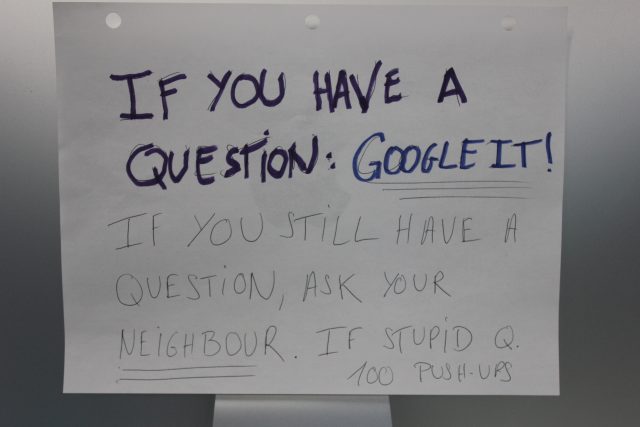In his 2008 blockbuster, Outliers, Malcolm Gladwell makes the case that a person’s age relative to his or her cohort is a key predictor of success. That is, the older you are in relation to your peers, the more likely you are to perform at an elite level in sports, to excel in school, and even to attend college. We see this principle applied in college athletics when coaches “redshirt” freshman athletes, allowing them to practice with the team but not play in official games. Redshirting gives younger athletes an additional year to develop skills and extends their playing eligibility, since colleges allow these freshmen five years to attend and compete.
On the other end of the student age spectrum, many parents of preschoolers have bought into this concept, choosing to delay their child’s entry into kindergarten for a year—a practice known as academic redshirting. Their justifications parallel those of college coaches: these parents believe that their children need that extra year to develop the necessary skills and maturity to succeed in kindergarten. A redshirted child is a year older at kindergarten entry and thus becomes one of the oldest in his class and remains so throughout his school years, enjoying the presumed advantages of age.
Preschools and elementary schools often recommend redshirting, asserting that it bestows the “gift of extra time,” but parents should take such advice with a grain of salt. After all, a preschool stands to gain financially from the practice, since the school will likely capture another year’s tuition. And elementary schools may also have mixed motives: older children are easier to teach and they perform at higher levels, just by virtue of being older. In other words, older children make the school’s job a little bit easier.
How should parents decide whether they should enroll their child in kindergarten when he is first eligible or hold him back for a year? In this article, we draw upon our combined experience—Schanzenbach as an education researcher and Larson as a preschool director—to provide some practical, evidence-based advice. Notably, we find that Larson’s take on the issue, formed by 14 years of experience with preschoolers and their parents, accords perfectly with Schanzenbach’s conclusions based on academic studies: redshirting is generally not worth it.
Despite the weightiness of the decision, rest assured that a child is likely to be successful whichever path his parents choose. We know dozens of families who have redshirted their children and have been perfectly happy with the outcome. On the other hand, in most instances there is a good case to be made for resisting the pressure—not only from schools but sometimes from other parents as well—and sending a child to school when he is first age-eligible.
Why Delay?
We recognize that deciding whether or not to redshirt a preschooler is difficult. Parents want what’s best for their children now and in the future, and they have to make the kindergarten-enrollment decision with limited and uncertain information. The concerns that lead parents to contemplate redshirting are most often related to the child’s physical, social, and emotional maturity as the parents perceive it. In particular, parents seem to wrestle most with the redshirting decision when they have a son whose fifth birthday falls just before the cutoff date for kindergarten eligibility, which is most commonly on or around September 1. If the child starts kindergarten “on time,” he will be among the youngest in his grade; if he is redshirted, he will be one of the oldest.
In terms of physical maturity, it is true that redshirting changes the child’s relative height in the kindergarten class. For example, using national data, we calculated that a summer-born boy who is in the bottom third of the national height distribution will be, on average, the fourth-shortest child in a class of 24. If he is redshirted, the height he gains during the additional year of preschool will move him closer to the middle of the pack. On the other hand, if the boy enters on time, he will also tend to gain relative height over the years, and by 3rd grade the odds are only fifty-fifty that he will remain in the shortest third of his class.
Emotional development presents a thornier issue. Parents correctly want their child to be able to walk into his kindergarten classroom with confidence—standing tall, asking questions, developing relationships with the teacher and with other students. If the child’s work habits or ability to sustain attention or fine motor skills are less advanced than those of his peers because he is younger, parents fear that the child will be left behind. One challenge here is that the child’s skill level in April, when the redshirting decision is often made, is a poor predictor of what his skills will be in September or October, when the school year is underway. Children’s development is highly uneven, with bursts of improvement in language, fine motor skills, and other capacities coming somewhat unpredictably.
Who Is Redshirted?
Most parents wrestling with these issues ultimately decide to enroll their child on schedule, as the vast majority of children are not redshirted. Among parents of the kindergarten class that entered in fall 2010, 6.2 percent reported that they delayed their child’s school entry by a year, and the share was slightly higher for boys (7.2 percent) than for girls (5.2 percent, see Figure 1a). The rate was higher among highly educated parents (see Figure 1b), with college graduates approximately twice as likely to redshirt their sons as high-school graduates are. The variation by parental education was especially stark for boys born during the summer months: among those with college-educated parents, approximately one in five was redshirted, a rate that is about four times as high as that for summer-born boys with high-school-educated parents. Note, however, that even among summer-birthday boys with college-educated parents, the great majority of them enter kindergarten on time.
The Research
In his analysis, Gladwell overstates the benefits of redshirting to some degree. In fact, a balanced look at the research suggests that while children derive a short-term gain from being redshirted, that advantage dissipates quickly over time.
It is difficult to study the impacts of redshirting because students who are redshirted differ across a host of dimensions from those who start on time. As noted, children of more-educated parents are more likely to be redshirted; separating out the effects of the delayed school entry from those of other characteristics, such as family background, presents a challenge.
No one has conducted a true randomized trial related to redshirting. Instead, researchers have sought out opportunities to isolate the effects on student outcomes of the two variables that by definition change when a student is redshirted: age itself and the student’s age relative to those of classroom peers. Once these effects are known, one can simulate the impact of being redshirted by statistically aging a kindergarten entrant by one year, and predicting the impacts of absolute age and of relative age on his outcomes.
The research literature includes many serious attempts to estimate the impact of being one of the oldest students in a class or grade, using variation in students’ age or relative age that is driven by external factors. For example, a study by Todd Elder and Darren Lubotsky leverages cross-state differences in birthday cutoff dates for kindergarten entry. In some states, a child must turn five by December 1 to be eligible for kindergarten in a given year; in others, the cutoff date is September 1. In states with earlier cutoff dates, eligible children who enter on time (and not a year late or early) are, on average, older than their counterparts in states with later cutoffs. These differences in state policy allow researchers to estimate the impact of the child’s age at kindergarten entry.
Another study, co-authored by Elizabeth Cascio and Diane Schanzenbach, uses data from the well-known Project STAR experiment in which students were randomly assigned to classrooms prior to kindergarten entry. Project STAR was initially designed to study the effects of reductions in class size. The random assignment of students to classrooms, however, meant that pairs of children with the same birthday fell into different positions in their classroom age distribution by the luck of the draw.
Both studies find that the benefit of being older at the start of kindergarten declines sharply as children move through the school grades. In the early grades, an older child will tend to perform better on standardized tests than his younger peers simply by virtue of being older. This makes perfect sense—a redshirted kindergartner has been alive up to 20 percent longer than his on-time counterpart, which means his brain has had more time to develop and he has had that many more bedtime stories, puzzles, and family outings from which to build his general knowledge. This initial advantage in academic achievement dissipates sharply over time, however, and appears to vanish by high school when, as a 9th grader, the redshirted student is at most 7 percent older than his peers.
One benefit that redshirting might indeed confer has to do with grade retention and special education placement. Statistically, older children are less likely to be retained in a grade or to be diagnosed with learning disabilities such as ADHD. This may be because schools make judgments about retention and referrals based on a student’s relative achievement within a grade, and by virtue of their age, older students are less likely to have very low achievement. Most parents who are considering redshirting, however, have children who are not likely to perform at levels that would put them at risk for grade retention; thus, we would argue that the slightly decreased probability of retention afforded by redshirting should in most cases be given relatively little weight.
The Influence of Peers
Both of us have stories of children who were redshirted and would likely have had a better school experience if they had enrolled on time. Larson tells the story of Joshua, a preschooler with a spring birthday who was on the low end of the normal developmental range in terms of work habits: he had trouble sitting still during circle time, for instance, and finishing multi-step projects. His parents decided to hold him back and give him an extra year of preschool. By fall, though, he had matured tremendously and clearly would have been flourishing in the kindergarten classroom. The following year, when he entered kindergarten at age six, Joshua was well ahead of his classmates and was often bored in class. Over subsequent years, he became demotivated and even developed behavioral problems. He was physically and emotionally more mature than his younger classmates and had trouble making friends.
Schanzenbach teaches Sunday school to preschoolers. It turns out that her experience in teaching college students does not transfer to good classroom-management practices for preschoolers, and the room can be somewhat chaotic at times. While some children sit on the story blanket and are engaged in listening to the short Bible lesson, others—typically the high-energy boys—tend to misbehave, goof off, and need constant reminders to pay attention. One little girl who was especially small for her age, Julia, would always sit front and center, actively listening and asking questions about the lesson. After story time one Sunday, as the kids were transitioning to the next activity, Julia walked up to her teacher, got within an inch of her face (as kids will do), and demanded to know, exasperated, “What is wrong with those boys? Why can’t they just sit still and listen?”
Not 30 minutes later, over coffee, the girl’s mother mentioned to Schanzenbach that they were planning to redshirt Julia because of her small stature. Schanzenbach tried to convince the woman that her tiny, bright, self-possessed girl would do just fine despite her small size, and in fact would be worse-off being delayed, because attending school with less mature peers would frustrate her. Nevertheless, Julia’s parents decided to redshirt her. Now in 3rd grade, she is bored, and frustrated by her less-mature classmates—and is still among the shortest in her class. It is likely that Julia, with her sharp intellectual curiosity and mature self-possession even at age five, would have been better-off starting school on time.
What do Joshua and Julia have in common? Because they were redshirted, they were both matched with younger peers. As the research literature confirms, the peer composition of a classroom is very important: not surprisingly, children benefit from being in a class with well-behaved, high-achieving children, and are harmed by the presence of poorly behaved classmates. One recent study by Scott Carrell, Mark Hoekstra, and Elira Kuka was able to measure the lasting detrimental impact of being in class with a disruptive peer in elementary school, suggesting that the presence of just one disruptive student out of 25 reduces the earnings of other students in young adulthood by a modest but measurable 3 to 4 percent.
Consistent with this evidence, the research on relative age indicates that being among the youngest in the class has benefits, in both the short and long term. Why? Because older classmates tend to be higher achieving and better behaved. They model positive behavior, and the younger students achieve greater academic gains from learning and competing with older ones. And two studies cited above—the one by Elder and Lubotsky and the one by Cascio and Schanzenbach—find that, with age held constant, learning with older classmates boosts students’ test scores.
For the older students, on the other hand, the positive impacts of being more mature are offset by the negative effects of attending class with younger students.
This is not to suggest that students would benefit from being in classrooms with far older children. The studies finding positive effects from older peers are based on classrooms where the age variation is typical—usually a few months. These results cannot be extrapolated to situations where a child is learning alongside much older students.
But one implication is that if a handful of families in a school decide to redshirt their children, they may be doing the other families a favor by improving the children’s peer group. Rather than feeling pressure to follow in their footsteps, parents may want to thank them.
In the Balance
Looking at the evidence, we advise parents to redshirt their child only in unique circumstances. Just what are those situations? Here we have less research to draw upon, but experience suggests a few scenarios. One is extreme developmental delay, outside of the normal range, to such an extent that another year’s development will potentially put the child in range of his classmates. Another is when a child is experiencing trauma, such as having a terminally ill parent or sibling.
Many instances of redshirting, however, involve parents who are trying to gain an advantage for their child down the line. Parents sometimes ask us whether redshirting their child will make him more likely to be accepted into gifted and talented programs. Although we could find no direct evidence in the research literature that this is the case, we can extrapolate from the literature that older children may indeed be more likely to be placed in a gifted and talented program. This depends on how schools assign students to such programs, in particular, whether a child’s eligibility is based on a comparison to other children in his grade or to other children his age. With variations according to individual talent, children’s test scores increase both as they get older and as they experience more years of schooling. So, within a given kindergarten classroom, a six-year-old will, on average, score higher than a five-year-old by virtue of being older. And a six-year-old in 1st grade will, on average, outscore a six-year-old in kindergarten, because the 1st grader has had an extra year of schooling.
If qualification for the gifted program is limited to the top 10 percent of the 1st graders, then being older may give some children an edge. (We are quick to add, though, that age tends to convey only small advantages that are likely to be trumped by differences in innate academic talent, and that there are many young-for-grade students in gifted programs.) On the other hand, if qualification is based on a test that is normed by age—and therefore six-year-olds are compared to other six-year-olds no matter what grade they are in—then the advantage may tip to the relatively younger child who has been in school longer.
And finally, parents should bear in mind that redshirting can even have an effect on their child’s economic future. Starting school at age 6 instead of age 5 means heading off to college at age 19 instead of age 18. (Perhaps spending an extra year with a teenager in the house is another cost to consider!) Then the student graduates from college and enters the workforce at age 23 instead of age 22. The redshirted individual will ultimately spend one less year in the labor force and forgo the returns of an extra year of experience throughout his working life. Assuming that, as research seems to indicate, being redshirted has no net long-term impacts on skill level, we can estimate the cost of losing that year in the labor force for a college-educated male who retires at age 67. Over the course of the worker’s career, working full time and year-round, he can expect to earn $80,000 less.
In sum, we find that redshirting at the kindergarten level bestows few benefits and exacts some substantial costs. Both research and experience suggest that the gains that accrue from being an older student are likely to be short-lived. Because of the important role of classroom peer effects, redshirted children can be educationally and socially harmed by being with others who are performing and behaving at lower developmental levels. Furthermore, while it is hard to predict a child’s likely growth trajectory in the months prior to his expected school entry, the perceived developmental delays and immaturity that prompt parents to choose redshirting in the spring have often resolved themselves by fall.
As any good educator will tell you, parents know their children best. There are multiple factors to weigh when deciding whether a preschooler is ready to thrive in kindergarten. What research tells us about the “average” child or “most” children may not apply to a particular son’s or daughter’s unique abilities and delays. Families might want to speak with parents of older children about their own kindergarten-enrollment decisions and how they view them in retrospect. And then, parents should follow their own best judgment.
Diane Whitmore Schanzenbach is professor of education and social policy at Northwestern University and a research associate at the National Bureau of Economic Research. Stephanie Howard Larson is the director of Rose Hall Montessori School in Wilmette, Illinois. Kin






